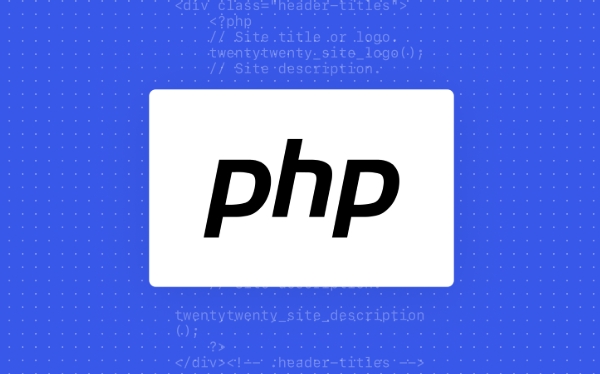 Backend Development
Backend Development
 PHP Tutorial
PHP Tutorial
 Are You Double-Escaping? Unraveling Common Pitfalls in PHP Data Sanitization
Are You Double-Escaping? Unraveling Common Pitfalls in PHP Data Sanitization
Are You Double-Escaping? Unraveling Common Pitfalls in PHP Data Sanitization
Jul 28, 2025 am 03:50 AMDouble-escaping occurs when data is escaped more than once, leading to corrupted output and false security; 1. escape only once, 2. escape at output time, not input, 3. use context-specific functions like htmlspecialchars() for HTML, prepared statements for SQL, 4. avoid input sanitization like strip_tags(), 5. store raw validated data and escape only when rendering, ensuring clean, flexible, and secure applications.

You might think you're making your PHP code safer by escaping data multiple times—once when it’s input, again when it’s output—but in reality, double-escaping is a common mistake that leads to messy, broken data and a false sense of security. Let’s clear up the confusion.

What Is Double-Escaping (and Why It’s Bad)
Double-escaping happens when you apply escaping functions more than once to the same piece of data. For example:
$name = mysqli_real_escape_string($conn, $_POST['name']); $name = mysqli_real_escape_string($conn, $name); // Oops! Escaped twice
Or using htmlspecialchars() repeatedly on output:

echo htmlspecialchars(htmlspecialchars($user_input, ENT_QUOTES, 'UTF-8'), ENT_QUOTES, 'UTF-8');
The result? Characters like ' become ', then '—leading to visible HTML entities on your page or corrupted data in your database.
Bottom line: Escape once, at the right time.

When (and How) to Escape: Input vs. Output
A common misconception is that you should sanitize or escape data as soon as it enters your application. But escaping depends on context, and you should only escape when you know where the data will be used.
? Escape on Output, Not Input
- Never escape data before storing it in the database unless you have a very specific reason.
- Instead, store raw user input (after proper validation), and escape it only when rendering in HTML, SQL, JavaScript, etc.
For example:
// Save clean data
$name = $_POST['name']; // validate, but don't escape
$stmt = $pdo->prepare("INSERT INTO users (name) VALUES (?)");
$stmt->execute([$name]);Later, when displaying:
// Escape for HTML context echo htmlspecialchars($name, ENT_QUOTES, 'UTF-8');
This keeps your data clean and flexible for different outputs (HTML, JSON, emails, etc.).
Use the Right Escape Function for the Context
Escaping isn’t one-size-fits-all. Different contexts require different functions:
- HTML output:
htmlspecialchars() - MySQL (with mysqli): Use prepared statements instead of
mysqli_real_escape_string() - JavaScript inside HTML:
json_encode()or careful escaping - URLs:
urlencode() - Shell commands:
escapeshellarg()orescapeshellcmd()
Using htmlspecialchars() before inserting into a database? That’s wrong.
Using mysqli_real_escape_string() before outputting to HTML? Also wrong.
Example of Context Mix-Up:
// ? Bad: Escaping for SQL when outputting to HTML echo mysqli_real_escape_string($conn, $comment); // ? Correct: Escape for HTML echo htmlspecialchars($comment, ENT_QUOTES, 'UTF-8');
Rely on Prepared Statements for SQL Safety
One of the biggest reasons people fall into escaping traps is to prevent SQL injection. But prepared statements eliminate the need to manually escape SQL inputs.
$stmt = $pdo->prepare("SELECT * FROM users WHERE email = ?");
$stmt->execute([$_POST['email']]);No manual escaping needed. The database driver handles it safely.
If you're still using mysql_real_escape_string() or mysqli_real_escape_string() to prevent SQL injection, you're doing it wrong—upgrade to prepared statements.
Bonus Pitfall: Over-Sanitizing with strip_tags() or filter_var()
Functions like strip_tags() or filter_var() can seem like a good idea, but they’re often misused:
$name = strip_tags($_POST['name']); // May not be necessary
This can silently corrupt valid input (e.g., someone named "Ana
Instead:
- Validate input (e.g., check length, format)
- Store it cleanly
- Escape only when outputting, based on context
Final Thoughts
Double-escaping usually stems from confusion about when and why to escape data. Remember:
- ? Escape once
- ? Escape at output time
- ? Use the correct function for the context
- ? Use prepared statements for SQL
- ? Don’t escape data for storage
Clean data in, properly escaped data out—that’s the golden rule.
Basically, stop trying to “sanitize everything” upfront. Focus on context-aware escaping, and you’ll avoid double-escaping and keep your apps safer and cleaner.
The above is the detailed content of Are You Double-Escaping? Unraveling Common Pitfalls in PHP Data Sanitization. For more information, please follow other related articles on the PHP Chinese website!

Hot AI Tools

Undress AI Tool
Undress images for free

Undresser.AI Undress
AI-powered app for creating realistic nude photos

AI Clothes Remover
Online AI tool for removing clothes from photos.

Clothoff.io
AI clothes remover

Video Face Swap
Swap faces in any video effortlessly with our completely free AI face swap tool!

Hot Article

Hot Tools

Notepad++7.3.1
Easy-to-use and free code editor

SublimeText3 Chinese version
Chinese version, very easy to use

Zend Studio 13.0.1
Powerful PHP integrated development environment

Dreamweaver CS6
Visual web development tools

SublimeText3 Mac version
God-level code editing software (SublimeText3)

Hot Topics
 Navigating Backslash Hell: A Deep Dive into `preg_quote()` and Regex Escaping
Jul 26, 2025 am 09:51 AM
Navigating Backslash Hell: A Deep Dive into `preg_quote()` and Regex Escaping
Jul 26, 2025 am 09:51 AM
preg_quote()escapesregex-specialcharacters,includingbackslashesandthedelimiter,totreatthemasliterals;2.avoiddouble-escapingbypassingrawstrings(e.g.,'C:\path')withoutpre-escapedbackslashes;3.useforwardslashesinpathswhenpossibletoreducebackslashclutter
 Escape Character Behavior in PHP's Heredoc and Nowdoc Syntaxes
Jul 26, 2025 am 09:45 AM
Escape Character Behavior in PHP's Heredoc and Nowdoc Syntaxes
Jul 26, 2025 am 09:45 AM
Heredoc handles variable interpolation and basic escape sequences such as \n, \t, \\, \$, but does not process \" or \', while Nowdoc does not perform variable interpolation and any escape processing. All contents, including \n and variables are output literally; 1. Variables such as $name will be replaced, \\n will be parsed as newlines; 2. $name and \n are kept as is true in Nowdoc; 3. No escape quotes are required for both; 4. The end identifier must occupy one line and no leading spaces. PHP7.3 allows the use of spaces to indent the end identifier. Therefore, Heredoc is suitable for multi-line strings that need to be formatted, and Nowdoc is suitable for outputting original content such as SQL or JavaScript.
 Single vs. Double Quotes: A Definitive Guide to Escape Character Behavior
Jul 28, 2025 am 04:44 AM
Single vs. Double Quotes: A Definitive Guide to Escape Character Behavior
Jul 28, 2025 am 04:44 AM
InBash,singlequotestreatallcharactersliterallywhiledoublequotesallowvariableexpansionandlimitedescaping;inPythonandJavaScript,bothquotetypeshandleescapesthesame,withthechoicemainlyaffectingreadabilityandconveniencewhenembeddingquotes,sousesinglequote
 Modern PHP Escaping Patterns for Secure and Clean Code
Jul 26, 2025 am 09:51 AM
Modern PHP Escaping Patterns for Secure and Clean Code
Jul 26, 2025 am 09:51 AM
Alwaysescapeoutputusingcontext-specificmethods:htmlspecialchars()forHTMLcontentandattributes,rawurlencode()forURLs,andjson_encode()withJSON_HEX_TAG,JSON_HEX_APOS,JSON_HEX_QUOT,andJSON_UNESCAPED_UNICODEforJavaScript.2.UsetemplatingengineslikeTwig,Lara
 The Art of the Backslash: Demystifying Escape Characters in PHP Regular Expressions
Jul 27, 2025 am 03:18 AM
The Art of the Backslash: Demystifying Escape Characters in PHP Regular Expressions
Jul 27, 2025 am 03:18 AM
TomasterbackslashesinPHPregex,understandthattwolayersofparsingoccur:PHPprocessesescapesequencesfirst,thentheregexenginedoes;2.UsesinglequotesforregexpatternstoavoidPHPinterpretingescapeslike\basbackspace;3.Indoublequotes,doublethebackslashes(e.g.,&qu
 A Comparative Analysis: `addslashes()` vs. `htmlspecialchars()` vs. `mysqli_real_escape_string()`
Jul 27, 2025 am 04:27 AM
A Comparative Analysis: `addslashes()` vs. `htmlspecialchars()` vs. `mysqli_real_escape_string()`
Jul 27, 2025 am 04:27 AM
addslashes() should be avoided for SQL escapes because it is not safe and not protected from SQL injection; htmlspecialchars() is used for HTML output to prevent XSS attacks; mysqli_real_escape_string() can be used for string escapes in MySQL queries, but is only a suboptimal option when preprocessing statements cannot be used. 1. addslashes() is outdated and unsafe and should not be used for SQL escape in modern applications; 2. htmlspecialchars() should be used when outputting user input and outputting to HTML to prevent XSS; 3. mysqli_real_escape_string(
 Beyond `addslashes()`: Contextual Escaping for Robust SQL Injection Defense
Jul 26, 2025 am 02:55 AM
Beyond `addslashes()`: Contextual Escaping for Robust SQL Injection Defense
Jul 26, 2025 am 02:55 AM
SQL injection protection cannot rely on addslashes() because it does not process multi-byte encoding and only escapes finite characters, which is easily bypassed; preprocessing statements (such as parameterized queries for PDO or MySQLi) should be used to separate the data from SQL logic to ensure that the input is not parsed into code; if preprocessing cannot be used, database-specific escape functions (such as real_escape_string and setting the correct character set), identifier whitelist or quotation mark wrapping, integer input casting and other methods should be used according to the context to achieve hierarchical defense.
 The Escaped Escaper: Handling Literal Backslashes in PHP Strings and Paths
Jul 26, 2025 am 09:35 AM
The Escaped Escaper: Handling Literal Backslashes in PHP Strings and Paths
Jul 26, 2025 am 09:35 AM
BackslashesgomissinginPHPbecausetheyaretreatedasescapecharactersindouble-quotedstrings,sotofixthis:1.Usesinglequotesforliteralpathslike'C:\Users\John\Documents',2.Ordoublethebackslashesindoublequotesas"C:\\Users\\\\John\\Documents",3.Prefer





